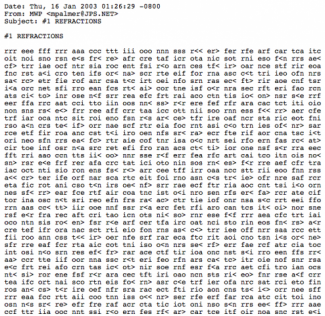Für die Herausgabe von als "codework" bekannten Arbeiten, haben die codework Theoretiker und Autoren Florian Cramer, Beatrice Beaubien und Alan Sondheim die bereits 1995 von Pit Schultz und Geert Lovink gegründete Plattform für Netzkritik gewählt. Geordnet nach Ausgabe, Betreffzeilen, E-Mail Adressen und den Autorennamen und ihren Aliasen, gewährt die Mailingliste einen Einblick in die von Autoren eingesandten codework Arbeiten.
Found by Pit Schultz and Geert Lovink to foster networked criticism in the nettime mailinglist since 1995, codework artists and theorists Florian Cramer, Beatrice Beaubien, and Alan Sondheim have chosen the nettime mailinglist as publishing outlet to edit codework submitted by artists between 2002 and 2003. Ordered according to the issue number, subject line, the author's E-Mail addresses and their names, the mailinglist offers a glimpse into the works submitted by artists.
Codework refers to the use of the contemporary idiolect of the computer and computing processes in digital media experimental writing, or [net.writing].
Writers and artists who have taken up the general practice of codework strive to foreground and theorize the relations between interface and machine and so reflect on the networked environment that constitutes and is constituted by a digital text. The precise techniques vary, but the general result is a text-object or a text-event that emphasizes its own programming, mechanism, and materiality.
Broadly, codework makes exterior the interior workings of the computer. One formal purpose is to bring the function and code of the computer to a kind of visibility. That is, to illuminate the many layers of code - the tower of programming languages that underlies the representation of natural languages on the screen. For all of the differences among particular instances or events of codework, they all incorporate elements of code, whether executable or not. Code appears in the text, then, in whole or in part, in the form of a functioning script, an operator, and/or a static symbol.
Codework participates in a larger movement that we might call the "art of code," in which the code used to produce the work seems to infiltrate the surface, the former domain only of natural languages and numeric elements. The art of code and the practice of codework has a socio-cultural history, more specifically origins within origins, and it is not limited to our contemporary moment. Its genealogy includes many instances of codes used as a medium for art, including Oulipo's Algol code poems and the use of computer instructions in their texts; the long-term tradition of generative aesthetics and poetic programming, such as Tristan Tzara's `algorithm' for Dadaist composition (including in a similar vein La Monte Young's and John Cage's instructional scores); ASCII art; the composition of Quines; and Perl poems.
There are other analogues: though not limited to an online environment, the formal, aesthetic, and political principles of codework as a general category are echoed throughout, and indeed informed by, net.art discourse: the two often have a common basis in hacker culture; Open Source advocacy; anti-corporatist politics; authorial and textual self-reflexivity; and software technics.
Alan Sondheim has carefully outlined a taxonomy of three types of codework: "Works using the syntactical interplay of surface language"; "Works in which submerged content has modified the surface language"; "Works in which the submerged code is emergent content."
Many codework practitioners indeed stress the socio-cultural significance, potential, and content, of their work. They claim, in sum, that codework expresses a revolutionary sensibility within the corporatized environment of IT by turning a pragmatic language toward aesthetic purposes; by issuing manifestos on cultural, political and aesthetic themes; by further complicating our postmodern understanding of authorship; and by articulating an anti-aesthetic, anti-bourgeois code of ethical writing practices.
Sondheim and others also suggest that codework's politics are clearly manifest in the genre's thematization of subjectivity, identity, and the body. They raise the issue of gendered agency, for example, or theorize text as flesh and introduce the problematic of abjection in order to think through the permeation of the boundaries between texts and discourses, or violations of the threshold between code and text. The linguistic-code divide, then, is conceptualized as a binary between the organic and the inorganic and as a binary between flesh and text.
Description on codework adapted from:
Raley, Rita. "Interferences: [Net.Writing] and the Practice of Codework." ebr (2002) http://electronicbookreview.com/essay/interferences-net-writing-and-the…

